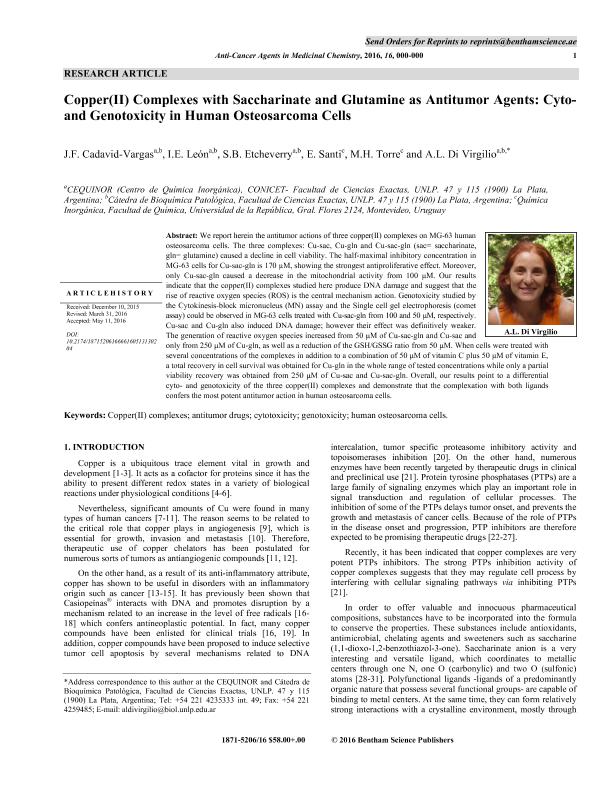Mostrar el registro sencillo del ítem
dc.contributor.author
Cadavid Vargas, Juan Fernando

dc.contributor.author
Leon, Ignacio Esteban

dc.contributor.author
Etcheverry, Susana Beatriz

dc.contributor.author
Santi, Eduardo
dc.contributor.author
Torre, Maria
dc.contributor.author
Di Virgilio, Ana Laura

dc.date.available
2018-06-12T17:57:58Z
dc.date.issued
2017-02
dc.identifier.citation
Cadavid Vargas, Juan Fernando; Leon, Ignacio Esteban; Etcheverry, Susana Beatriz; Santi, Eduardo; Torre, Maria; et al.; Copper(II) Complexes with Saccharinate and Glutamine as Antitumor Agents: Cytoand Genotoxicity in Human Osteosarcoma Cells; Bentham Science Publishers; Anti-cancer Agents In Medicinal Chemistry; 17; 3; 2-2017; 424-433
dc.identifier.issn
1871-5206
dc.identifier.uri
http://hdl.handle.net/11336/48376
dc.description.abstract
We report herein the antitumor actions of three copper (II) complexes on MG-63 human osteosarcoma cells. The three complexes: Cu-sac, Cu-gln and Cu-sac-gln (sac= saccharinate, gln= glutamine) caused a decline in cell viability. The half-maximal inhibitory concentration in MG-63 cells for Cu-sac-gln is 170 μM, showing the strongest antiproliferative effect. Moreover, only Cu-sac-gln caused a decrease in the mitochondrial activity from 100 μM. Our results indicate that the copper (II) complexes studied here produce DNA damage and suggest that the rise of reactive oxygen species (ROS) is the central mechanism action. Genotoxicity studied by the Cytokinesis-block micronucleus (MN) assay and the Single cell gel electrophoresis (comet assay) could be observed in MG-63 cells treated with Cu-sac-gln from 100 and 50 μM, respectively. Cu-sac and Cu-gln also induced DNA damage; however their effect was definitively weaker. The generation of reactive oxygen species increased from 50 μM of Cu-sac-gln and Cu-sac and only from 250 μM of Cu-gln, as well as a reduction of the GSH/GSSG ratio from 50 μM. When cells were treated with several concentrations of the complexes in addition to a combination of 50 μM of vitamin C plus 50 μM of vitamin E, a total recovery in cell survival was obtained for Cu-gln in the whole range of tested concentrations while only a partial viability recovery was obtained from 250 μM of Cu-sac and Cu-sac-gln. Overall, our results point to a differential cyto-and genotoxicity of the three copper (II) complexes and demonstrate that the complexation with both ligands confers the most potent antitumor action in human osteosarcoma cells.
dc.format
application/pdf
dc.language.iso
eng
dc.publisher
Bentham Science Publishers

dc.rights
info:eu-repo/semantics/openAccess
dc.rights.uri
https://creativecommons.org/licenses/by-nc-sa/2.5/ar/
dc.subject
Antitumor Drugs
dc.subject
Copper (Ii) Complexes
dc.subject
Cytotoxicity
dc.subject
Genotoxicity
dc.subject
Human Osteosarcoma Cells
dc.subject.classification
Otras Ciencias Biológicas

dc.subject.classification
Ciencias Biológicas

dc.subject.classification
CIENCIAS NATURALES Y EXACTAS

dc.title
Copper(II) Complexes with Saccharinate and Glutamine as Antitumor Agents: Cytoand Genotoxicity in Human Osteosarcoma Cells
dc.type
info:eu-repo/semantics/article
dc.type
info:ar-repo/semantics/artículo
dc.type
info:eu-repo/semantics/publishedVersion
dc.date.updated
2018-06-12T13:32:33Z
dc.journal.volume
17
dc.journal.number
3
dc.journal.pagination
424-433
dc.journal.pais
Estados Unidos

dc.journal.ciudad
Oak Park
dc.description.fil
Fil: Cadavid Vargas, Juan Fernando. Consejo Nacional de Investigaciones Científicas y Técnicas. Centro Científico Tecnológico Conicet - La Plata. Centro de Química Inorgánica "Dr. Pedro J. Aymonino". Universidad Nacional de La Plata. Facultad de Ciencias Exactas. Centro de Química Inorgánica "Dr. Pedro J. Aymonino"; Argentina. Universidad Nacional de la Plata. Facultad de Ciencias Exactas. Departamento de Ciencias Biológicas. Cátedra Bioquímica Patologica; Argentina
dc.description.fil
Fil: Leon, Ignacio Esteban. Consejo Nacional de Investigaciones Científicas y Técnicas. Centro Científico Tecnológico Conicet - La Plata. Centro de Química Inorgánica "Dr. Pedro J. Aymonino". Universidad Nacional de La Plata. Facultad de Ciencias Exactas. Centro de Química Inorgánica "Dr. Pedro J. Aymonino"; Argentina. Universidad Nacional de la Plata. Facultad de Ciencias Exactas. Departamento de Ciencias Biológicas. Cátedra Bioquímica Patologica; Argentina
dc.description.fil
Fil: Etcheverry, Susana Beatriz. Consejo Nacional de Investigaciones Científicas y Técnicas. Centro Científico Tecnológico Conicet - La Plata. Centro de Química Inorgánica "Dr. Pedro J. Aymonino". Universidad Nacional de La Plata. Facultad de Ciencias Exactas. Centro de Química Inorgánica "Dr. Pedro J. Aymonino"; Argentina. Universidad Nacional de la Plata. Facultad de Ciencias Exactas. Departamento de Ciencias Biológicas. Cátedra Bioquímica Patologica; Argentina
dc.description.fil
Fil: Santi, Eduardo. Universidad de la República; Uruguay
dc.description.fil
Fil: Torre, Maria. Universidad de la República; Uruguay
dc.description.fil
Fil: Di Virgilio, Ana Laura. Consejo Nacional de Investigaciones Científicas y Técnicas. Centro Científico Tecnológico Conicet - La Plata. Centro de Química Inorgánica "Dr. Pedro J. Aymonino". Universidad Nacional de La Plata. Facultad de Ciencias Exactas. Centro de Química Inorgánica "Dr. Pedro J. Aymonino"; Argentina. Universidad Nacional de la Plata. Facultad de Ciencias Exactas. Departamento de Ciencias Biológicas. Cátedra Bioquímica Patologica; Argentina
dc.journal.title
Anti-cancer Agents In Medicinal Chemistry

dc.relation.alternativeid
info:eu-repo/semantics/altIdentifier/doi/https://dx.doi.org/10.2174/1871520616666160513130204
dc.relation.alternativeid
info:eu-repo/semantics/altIdentifier/url/http://www.eurekaselect.com/142141/article
Archivos asociados
